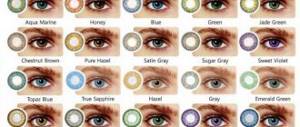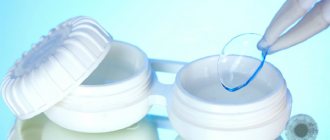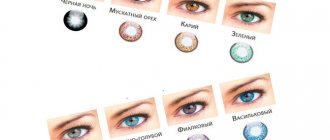Myopia and astigmatism are two diseases that often complement each other. That is, a person suffering from myopia often faces astigmatism. Correction of such defects is carried out using glasses or lenses. And people suffering from these diseases are often concerned about the question of whether it is possible to find a remedy that can be used simultaneously for both diseases. Is it possible to wear, for example, the same lenses for astigmatism and myopia? This material will focus specifically on this correction tool, since it is what most people with such defects and vision problems prefer to use.
Lenses for astigmatism and myopia
Why lenses?
Pros and cons of contact lenses
Such a means of correction as lenses, which have now become familiar and familiar to everyone, and which are easy to buy not only in optics, but even in some supermarkets, is in fact a fairly young means of vision correction, which came into use much later than glasses. But they quickly gained popularity among people suffering from visual impairments. And this is not surprising - this correction tool has a lot of undeniable advantages over glasses:
- the lenses are convenient to use - they do not interfere with a number of actions;
- they do not fog up during sudden temperature fluctuations;
- you can drive a car with them, play sports, swim and not be afraid of breaking or losing them;
- they are easy to use, clean and maintain;
- the products are aesthetically much more attractive than glasses.
Lenses look more attractive than glasses
True, it is not recommended for people with vision problems to buy the first lenses they come across. They should be selected by a specialist based on the examinations performed and based on certain indicators . It is especially important to choose the right products precisely in the presence of astigmatism. This pathology requires a rather complex correction - correction of the defect is achieved only through correction simultaneously horizontally and vertically, which is not necessary if there is only myopia.
Astigmatism. What it is
On a note! In the presence of astigmatism, the human eye partially changes its shape, the lens or the corneal part of the eye becomes oval, which is why the objects visible to it become blurry - the focusing of light rays on the retina occurs not in one place, but in several at once. By the way, astigmatism can accompany not only myopia, but also farsightedness. Untreated pathology can lead to the development of other diseases.
Types of astigmatism
So what is astigmatism?
Astigmatism is an eye disease in which the cornea or lens of the eye becomes irregularly shaped. With this disease, the lens or cornea takes on a slightly elongated shape that is not uniform in density. As a result, light rays hit not one point in the center of the cornea, but two different ones, which leads to blurred vision. Any minor damage to the eye, as well as serious trauma, can lead to this condition. There are also cases when a person sees objects curved and blurry.
Lenses for astigmatism
Diagnosis of astigmatism
The combination of this disease and myopia is usually called myopic astigmatism. There are two types - lenticular and corneal. Usually the second option is acquired as a result of corneal deformation. But the lens can be congenital. Doctors distinguish three degrees of astigmatism:
- up to 3 diopters (yes, astigmatism is also measured in diopters) - this is a weak degree, often not noticeable to the patient himself, and is identified by the doctor during an examination;
- 3-6 diopters – considered average, at which the quality of vision is really noticeably distorted and adjustment is necessary;
- more than 6 diopters is a high, significant degree at which the patient complains of double vision and severe distortion of the outlines of visible objects.
Cornea with astigmatism
Sometimes, even when a mild degree of astigmatism is detected, people ignore the doctor’s instructions and do not want to wear regular glasses for a number of reasons. Then it’s time to turn to the use of lenses, since this disease cannot be left completely without correction.
Special lenses, the so-called toric ones, help correct defects such as astigmatism. They have a certain configuration and a special surface located on the front or back side of the product. They are recommended for use if a person’s astigmatism exceeds 0.75 diopters. A toric lens is able to sit firmly on a person’s eye in a certain position, due to which it is possible to improve visual acuity.
Spherical and toric lenses
The advantages of toric lenses include:
- the possibility of correcting even a severe degree of pathology;
- ensuring high clarity of vision without distortion, which often occurs when wearing glasses;
- the possibility of creating a unified vision system together with the eye;
- providing eye protection from ultraviolet radiation;
- the ability to correct vision without reducing aesthetic appeal.
Table. Types and features of toric lenses.
| View | Description |
| Soft | They are made from a special material. These lenses are really soft and very gentle to the touch. You need to wear them during the day, taking them off at night, or there are so-called night lenses. Each pair has its own wear period, after which the pair must be replaced with a new one. |
| Hard | This type is quite dense, but at the same time the material used for their manufacture is capable of transmitting oxygen to the tissues of the eye, which they need. They last longer than soft ones. You only need to wear them during the day, taking them off at night and putting them in a container. |
It is important to remember that standard lenses, which are usually worn by patients with only myopia, are not suitable for correcting pathology such as astigmatism. To choose the right ones, it is important to make an appointment with a specialist who will take into account a lot of indicators before writing a prescription for the purchase of lenses.
Toric contact lens
Important! It is worth remembering that incorrectly chosen lenses can lead to deterioration of the condition of the eyes and vision and aggravation of the situation as a whole.
Toric products for correcting astigmatism are not without their drawbacks. They can provoke the development of inflammation, however, this can also be caused by incorrect wearing of conventional lenses intended only for the correction of myopia or farsightedness. Also, the eyes may simply get tired from this product. In rare cases, deterioration of vision or oxygen starvation of eye tissues is observed.
Eyes can get tired from lenses
Also, lenses, both regular and toric, can slightly change the shape of the cornea. However, if you stop wearing these correction products, its shape will quickly be restored to its natural one. Only in rare cases does this process remain unchanged and may affect the possibility of laser vision correction .
Contact Lens Materials
Rules for selecting contact lenses
If you are farsighted, only a qualified doctor can determine which lenses you need. He will also give practical advice regarding the type and mode of use of such products. Purchasing SCLs on your own without first consulting an ophthalmologist is almost certainly a waste of money, and sometimes the cause of complications.
To correctly select lenses for farsightedness, the following diagnostic procedures may be necessary:
- Visometry;
- Refractometry;
- Ophthalmoscopy;
- Accomodometry;
- Checking lateral vision and binocular functions of the eyes.
Here are the main criteria that need to be taken into account when choosing an SCL:
- Optical power
– this indicator is measured in diopters and characterizes the degree of hypermetropia in a particular patient;
- Radius of curvature
– the structure of the eyeballs may vary between people, but most patients are suitable for lenses with a standard radius of 8.6 mm;
- Water content
– the higher it is, the softer and more comfortable the product, however, harder specimens provide better clarity of vision;
- Oxygen permeability
– the risk of complications depends on it: “breathing” SCLs are safer in this regard;
- Tensile strength
– directly affects the service life of each individual pair of contact lenses.
Conventional lenses for astigmatism
Standard lenses used to correct distance or near vision are not recommended for those with astigmatism. The reason lies in the fact that the correction occurs only in one plane, and the lenses themselves can change their position when making eye movements or blinking.
Regular contact lenses should not be used by those with astigmatism.
Of course, many people still wear them, especially when the quality of their vision does not allow them to refuse to wear any means of correction, but they don’t want to wear glasses. But with a high degree of astigmatism, negative effects such as headaches and eye fatigue may appear. It is best to purchase lenses that are specially selected and manufactured in accordance with individual indicators.
Classification of lenses
The entire variety of contact lenses produced today can be classified according to several criteria.
- By time of scheduled lens replacement:
- one-day;
- two weeks;
- period;
- quarterly;
- traditional (service life 6-9 months).
- According to wearing mode:
- daytime - can be used for 8-10 hours, they must be removed at night;
- extended wear lenses – can be worn without removing, depending on the brand, from 1 to 7 days.
- Depending on the material of manufacture:
- soft contact lenses;
- hard contact lenses;
- Special Design Lenses:
- spherical – most traditional contact lens models;
- aspherical – have improved optical characteristics;
- toric – designed to correct astigmatism;
- multifocal – have several zones with different optical powers, suitable for correcting presbyopia;
- orthokeratological - special lenses that are worn while sleeping at night to temporarily improve visual acuity during the day;
- therapeutic – used for temporary protection of the corneal surface after microsurgical operations;
- color contact lenses;
- carnival lenses (crazy).
There are three main types of colored contact lenses: decorative, tint and cosmetic. What is important is that colored contact lenses are used not only by people with good vision, but also by those who suffer from myopia, astigmatism or farsightedness.
Most colored lenses are designed to be reusable, but disposable ones are also available. The high ability to transmit oxygen creates comfortable conditions for the eyeball to function normally.
It is worth noting that even ordinary “non-colored” contact lenses for vision correction have a barely noticeable bluish or greenish tint. Manufacturers make this move to make the lens easier to distinguish in solution, or if it suddenly falls. Such a light tint of the contact lens does not affect the color of the eyes.
- Tinted colored contact lenses are transparent, their color is only slightly richer than that of regular contact lenses. They are worn to emphasize the beauty and expressiveness of the eyes, and to slightly change their color. Such lenses are suitable exclusively for those with light eyes, because for brown-eyed people they simply will not be noticeable.
- Cosmetic lenses are distinguished by the fact that they are opaque, due to which they can radically change the color of a person’s eyes. For example, even dark brown eyes can be easily turned into light blue with the help of such lenses. Thus, if you have dark eyes, you will need just such lenses to change the natural color of your eyes. It is worth noting that today manufacturers offer a huge variety of colors, ranging from classic ones - green or blue, to exquisite and fancy colors - amethyst, lavender, mint, etc.
- Decorative lenses are also called carnival or Crazy lenses. These are bright, extravagant lenses with fancy colors or patterns that allow you to surprise or even shock others. They are often used for theme parties, carnivals, etc. Such lenses can, for example, imitate a cat's eye and come in the most incredible colors.
It is important to remember that carnival lenses are not suitable for constant daily wear, since they are significantly thicker than ordinary lenses, and, accordingly, their ability to pass air is worse. Visual acuity and contrast perception in such lenses is significantly reduced.
Lens selection
When selecting lenses, the doctor will follow the same algorithm as when selecting glasses for a patient. That is, he will send the patient for the same studies that he would go for if he wanted to buy corrective glasses for himself. After conducting the research, the doctor simply interprets the results and writes a prescription. The study determines:
- certain optical correction components;
- tilt of the cylindrical axis for both eyes separately;
- radius of curvature of the base adjustment tool.
Correct selection of optical lenses
Lenses for astigmatism correction
TCL for the correction of astigmatism is selected by a professional ophthalmologist.
They are prescribed if astigmatism is more than 0.75 diopters. To select, you need to know the dioptres, power, and cylinder axis for your eyes. It is possible to recognize them only with the help of a specialist using a special device.
The patient quickly adapts to TCLs; they can be used for swimming and physical exercise. If there is discomfort, the doctor reduces the number of diopters, but this worsens the quality of vision and increases astigmatism.
When there is a large difference in visual acuity between the eyes, SCLs are used to preserve binocular vision.
Wearing Features
So, the man turned to an ophthalmologist, and he, in turn, after conducting a series of studies, established an accurate diagnosis and determined a number of parameters that allowed him to find out what lenses the patient would need to correct the quality of vision. But lenses that are effective for both myopia and astigmatism have their own specific characteristics. So, having become the proud owner of this correction tool, it is worth remembering that putting on toric lenses is somewhat more difficult than ordinary soft ones. The fact is that they must be in the correct position on the cornea - the so-called meridians of the eye must coincide with a number of meridians of the products themselves. A lens, when put on correctly and in its intended place, will not move or interfere with the eye.
Rules for wearing lenses
On a note! It was possible to ensure that the lens “sits” on the eyeball as it should be thanks to some thickening of its lower part.
Also, at first, you should not hope that wearing lenses will be possible without discomfort, especially if a correction device (at least glasses) has not been used since childhood. You will have to get used to it gradually, that is, start wearing it for a short time at first, increasing the period of wear every day. Usually addiction lasts about a week.
Contact lenses are the best option for vision correction. They are ideal for those people who do not like to wear glasses, they have a big “minus”
Attention! If the discomfort does not go away within a week, then it is important to consult a doctor to select another means of correction.
Why are they needed - colored toric lenses
The main task of astigmatic contact lenses is to eliminate astigmatism - a disease of the visual organs associated with pathological changes in the shape of the corneas and lenses, in which a distorted image is formed on the retina of the eye.
Read about the instructions for using Oxial eye drops here. In addition, they are effective for various corneal injuries, cataracts and some other ailments.
Toric lenses differ from the more familiar spherical ones in two important components:
- have a spherocylindrical (toric) shape, resembling a donut in appearance;
- have two optical powers, the first of which helps correct astigmatism, and the second takes on the correction of farsightedness or myopia.
Among the variety of toric lenses, colored products stand out, made of soft, flexible materials and designed to add additional charm to the appearance thanks to color nuances.
At the same time, changing the color of the iris makes the eye shade more saturated and deeper, while maintaining naturalness. You can also additionally wear zero glasses for image.
On video: why do you need toric colored lenses?
Brands and manufacturers
The market now offers lenses made from a variety of materials. Unfortunately, there are not so many correction means suitable for both those who suffer from myopia and those who have astigmatism. And, nevertheless, you can choose something suitable.
The following lenses are made from silicone hydrogel. These are products from Air Optix, Biofinity, Acuvue Oasys and a number of others. Their name should be complemented by words such as “toric” or “astigmatism”. If there are such additions, then the products are suitable for use by people suffering from this pathology. The most comfortable to wear and the best options regarding moisture content and oxygen permeability are lenses from Biofinity and Acuvue Oasys.
Biofinity toric lenses
On a note! The wearing time for lenses may vary. This information should be provided on the lens packaging. The wearing period of the products cannot be exceeded.
Among hydrogel lenses, astigmatists with myopia can be advised to purchase Softlens daily disponsible, Biomedics or Focus DAILIES. Among them there are those that are worn only for one day and require replacement, as well as those that can be worn for an entire month or even more.
Soflens Daily Disposable Toric
Criterias of choice
Ophthalmologists are often asked whether it is possible to wear regular lenses if you have astigmatism. Using simple optical devices for cosmetic purposes will only change the color of the eyes, but will not improve visual function in any way. Such lenses are currently available to everyone, and according to statistics, more than 125 million people around the world use them, regardless of their purpose.
In order to choose lenses, it is worth undergoing a comprehensive examination by a specialist who will determine the nature, degree and type of pathology. For this purpose, computer diagnostics is used.
What to consider when choosing lenses:
- visual acuity;
- how much the lens is bent;
- the presence of other diseases associated with visual function;
- cornea size;
- how comfortable a person feels in the chosen lens model;
- exact location of the meridian.
Can I wear plain lenses if I have astigmatism? These varieties include one-day models that do not require special care. They are worn only during the day, and in the evening the eyes are rested. Lenses can be easily tinted and correct not only visual function, but also make the color of the pupil more saturated and pronounced.
How to care?
Despite the apparent complexity, lens care is quite simple, and even children can follow simple rules. But taking care of cleanliness is an important component of not only the correct use of correction products, but also a guarantee that your eyes will be clear and healthy.
Step 1. It is important to store lenses only in a solution specially designed for this purpose. Do not use any other liquids, even if they seem suitable. The fact is that the lens solution itself is not only an excellent medium for storing the product, but also an additional means of cleaning it. It is also important to check the expiration date of the product - it is prohibited to use old ones.
Store contact lenses correctly
Step 2: It is important to use special screw-on storage containers. Moreover, it is important to buy those that are marked on the covers “L” and “R”, which means “left” and “right”. It is impossible to confuse lenses from different eyes - they can differ not only in optical characteristics, but also in shape. Each product must be placed only in the container intended for it.
Lens container
Step 3. Both remove and put on these products only with clean hands, previously washed with soap and dried with a lint-free towel.
Hands must be clean
Step 4. After removing the lenses, wipe them with your fingers. This will get rid of deposits and dirt that have accumulated during wear. If deposits are not removed, the lens becomes cloudy, vision deteriorates, and inflammatory processes may develop. You can wipe the lenses with your finger, placing them on a clean palm. You must act carefully so as not to damage the product.
Clean lenses with your fingers
Step 5. While wearing lenses, you can use artificial tear drops. They will help get rid of dry eye syndrome. Drops that are incompatible with wearing lenses can only be used after removing the products themselves.
Artificial tears may be used
Step 6. Do not put lenses on sore eyes. During treatment for any eye diseases, it is recommended to change them to glasses.
It is better to avoid contact lenses during treatment.
Step 7. Even in an emergency, do not moisten or wet the lens with saliva. It contains too many microorganisms that are dangerous to the eyes.
Don't wet your lenses with saliva
Step 8. It is prohibited to wash the lens with plain water. The reason is the very microorganisms present in the water.
Only special solutions should be used
Step 9. It is important to ensure that the lenses do not expire. You cannot wear those that have already served their purpose.
Keep an eye on expiration dates
Video – Astigmatism and contact lenses
You cannot choose lenses for a combination of astigmatism and myopia on your own. It is important to consult a doctor who will help you make the right choice, taking into account all the features of the structure of the eyes and the quality of vision. So it’s worth getting examined by a specialist at least once, and then buying the lenses that will be indicated in the prescription. And in any case, it is important to regularly visit an ophthalmologist to examine your eyes and check the quality of your vision in order to be calm about your health and monitor changes (if any) occurring in the eyes.
Lenses or glasses?
When choosing a correction tool, you need to consider the following advantages of contact lenses for astigmatism and myopia:
- the ability to correct high levels of optical distortion;
- minimal change in the emerging image on the retina;
- expanded field of view;
- creating favorable conditions for the functioning of both eyes;
- no fogging;
- reliable fixation, providing convenience for sports activities;
- aesthetic appearance (invisibility to others).
Some users may experience discomfort when wearing lenses. Models of Sidorenko vacuum glasses for correcting astigmatism are characterized by increased thickness, which makes it difficult to get used to. Experts note other disadvantages:
- the complex shape of toric lenses creates optical distortions;
- with prolonged wear, it is possible that the size of the cornea may change;
- sometimes patients complain of eye fatigue;
- Pain and allergic reactions cannot be ruled out.
What is better, glasses or contacts, can be determined after consulting an ophthalmologist. If necessary, an experienced specialist will prescribe additional diagnostic examinations. The recommendations received will help you choose the optimal correction tool, taking into account the physiological characteristics of the patient.
For myopia, glasses are chosen when it comes to rare use (going to the cinema, driving a car). Contact lenses are more convenient for regular use!
Prices
For comparative analysis, below is the cost of popular contact lenses as of January-February 2020:
| Model | Number of lenses in standard packaging, pcs. | Moisture contents, % | Dk/t | Price range, rub. |
| OK VISION Season | 2 | 45 | 28 | 320-360 |
| Gelflex Sea Clear | 6 | 47 | 24 | 920-980 |
| CooperVision Proclear Compatibles | 6 | — | 42 | 1160-1280 |
| ALCON Air Optix plus HydraGlyde | 6 | 33 | 138 | 1790-1940 |
| ACUVUE Oasys with Hydraclear Plus | 12 | 38 | 147 | 1940-2080 |
User reviews
It is necessary to emphasize the subjectivity of the opinions of ordinary users. Discomfort can be explained by physiological characteristics and unique allergic reactions. The assessment is influenced by operating conditions: work intensity, lighting, and other factors.
Conclusions and recommendations
The specialized online store offers automated selection based on radius of curvature and optical power for quick search. A detailed description will help clarify the water content and other basic parameters. It is recommended to pay attention to the latest models with improved consumer characteristics to ensure the required level of comfort.
Whether it is possible to wear lenses for myopia (astigmatism, farsightedness) will be explained by an experienced doctor during the consultation. The prescribed prescription is used for no more than one year. Timely diagnosis will help identify significant physiological abnormalities and diseases. In addition to corrective agents, a set of therapeutic and preventive measures is used to eliminate problems.
Manufacturers
Are you wondering what astigmatic contact lenses are, how to wear them and where to buy them? A specialist will be able to answer these questions after a comprehensive diagnosis. Aspherical, cylindrical and toric lenses are suitable for correcting astigmatism. The latter model is used most often because it allows you to improve the quality of visual function in the presence of not only this disease, but also other eye pathologies.
Most often, toric lenses are made from hydrogel. It does not disturb the lipid membrane, contains a sufficient amount of oxygen, and therefore does not cause discomfort when worn. Lens companies that stand out in the market include Maxima Optics, CIBA Vision, Cooper Vision, Johnson & Johnson and Interojo. It is better to purchase them for the first time in a specialized store or pharmacy and only after a comprehensive examination. Products can also be purchased online, which is a fast and convenient way.
The most popular models of astigmatic contact lenses by reviews and price:
- Biofinity Toric - characterized by a perfect design, high oxygen permeability, low elasticity, designed for 1 month if used only during the day (cost about 1.5 thousand rubles).
- PureVision 2 Toric - contain a moisturizing component for easy and comfortable wearing, a large diameter for centering the cornea and clear image reproduction regardless of lighting (from 1260 rubles).
- Acuvue Oasys are two-week lenses with a moisturizing component and the maximum level of protection. Only good reviews are left about them (price from 1 thousand rubles).
- Air Optix for Astigmatism are toric lenses that have a soft, smooth and stable surface, are not susceptible to contamination, and the surface remains transparent even after a month of regular use (from 1040 rubles).
How lenses are made
Making contact lenses is a complex and high-tech process, especially when it comes to optics for people with astigmatism. In total, there are 4 technological processes that make it possible to obtain optics. However, only 3 of them are suitable for the manufacture of toric CLs:
- turning;
- casting;
- reverse reverse process.
“Circulation products” of large companies, as a rule, are manufactured by casting, which ensures the relative cheapness of optics while maintaining the necessary characteristics. Silicone hydrogel or hydrogel CLs are cast in a mold - a special matrix, which is created using a precision method. Selective control of optics (for example, for Bausch & Lomb it is 10% of the batch) ensures control of the parameters of produced lenses. But casting does not allow the implementation of complex TCL geometry that can be prescribed to a patient. For the most part, these are mass-produced and cheap contact lenses that provide the desired corrective effect.
For the production of small-scale products, turning is used. This is a complex and labor-intensive process consisting of processing the workpiece with a lathe followed by polishing. Accordingly, the cost of production turns out to be slightly higher in comparison with other methods. True, the accuracy of the stated parameters is absolute - each lens undergoes technical control at each stage of production.
The reverse reverse process combines the advantages of both casting and turning. The technology is slightly less expensive in comparison with completely mechanical technology, but more expensive in comparison with “stamping”. Just like turning, it allows you to realize complex geometry.
Each manufacturer has its own technological processes and “highlights”, but for the end consumer of contact lenses they do not matter. What comes to the fore is only the method of stabilization (that is, what ensures the correct position of the lens on the pupil) and the material used, as well as the duration of wear.
Price
Prices for toric color lenses depend on the following components:
The cheapest are “one-day” lenses - about 45 rubles. a piece. Considering that the package contains 90 pieces, it will cost you about 4 thousand rubles.
As the wearing period increases, the products become more expensive: for 6 lenses designed for weekly wear, you will pay about a thousand.
Optics designed for a month cost from one and a half thousand for three lenses.
Recommendations
When using multiple models, care must be taken to clean them using special cleaning agents. In addition, they must be stored in special solutions.
When purchasing colored toric lenses, you should keep in mind that they cannot be worn longer than indicated in the instructions for use - this can lead to new eye problems.
In any case, in order to avoid unwanted manifestations, the use of these optical devices should be supervised by a qualified ophthalmologist.
In conclusion, we note once again: the use of colored toric lenses is a good opportunity for astigmatists not only to correct their vision, but also to look stylish and respectable, emphasizing the beauty and expressiveness of the eyes.
Types of astigmatism and their correction
The correct selection of glasses for astigmatism depends on the degree of astigmatism. Ophthalmologists recommend using glasses together with special lenses, since with severe astigmatism there can be various complications from prolonged wearing.
These include dizziness, increased fatigue, and sore eyes. If this is an unexpressed congenital disorder, plus or minus glasses can completely restore the ability to fully see.
Advice! If you experience headaches, nausea, or pain in the eyes, you need to stop wearing glasses for a while and find a better option. It is also recommended to constantly use eye drops to reduce discomfort and quickly get used to the lenses.
Types of astigmatism
- Congenital astigmatism - manifests itself more in young children with a congenital disorder. In some cases, it does not interfere with a person’s vision and is functional, that is, a normal deviation. Timely selection of lenses completely corrects vision. The need to constantly wear corrective lenses appears only after exceeding the limit of 1 diopter. In this case, vision is greatly reduced and the person sees objects blurred. Complex glasses with cylindrical lenses are an ideal option for congenital visual impairment.
- Acquired astigmatism - appears after operations or traumatic injuries. The formation of scars on the eye leads to changes in the cornea, but such an anomaly is much more difficult to correct.
In the case of congenital astigmatism, glasses should be selected with a weak corrective effect and subsequently replaced with complex glasses. If treatment is carried out already in adulthood, you need to pay attention to the reaction of the eyes after wearing various glasses.
Soreness, darkness before the eyes, dizziness indicate the need to reassess the state of vision and change the correction method.
Simple astigmatism
Simple astigmatism is diagnosed in people at 3 diopters. The use of optical glasses in this case is the only correct treatment option.
First you need to choose weak glasses for your eyes to get used to, and only after a few months, or even six months, replace them with strong ones with cylindrical or toric lenses. Toric glasses are quite difficult to choose; you will have to replace them several times until the best option is found.
Advice! Finding glasses on your own can take a long time and lead to visual discomfort. After unsuccessful attempts, you need to be examined again by an ophthalmologist, since vision with a mild form of astigmatism can gradually worsen or, on the contrary, become better.
Complex astigmatism
A special feature of complex astigmatism is intolerance to certain types of lenses. Such a person cannot even wear glasses with regular lenses, this leads to a worsening of the condition. With this diagnosis, it is recommended to combine both glasses and contact lenses to correct farsightedness and myopia. Why is the use of one method ineffective for complex astigmatism?
- They do not provide lateral vision, which disrupts the stereoscopic effect.
- They limit the space of perception, which can be attributed to the main disadvantage in relation to drivers.
- Constant visual fatigue, dry and burning eyes.
- Uncomfortable to wear due to frequent contamination and fogging. Glasses can break, and if for some reason this happens on the face (minor accident, blow), it can cause serious damage to the eye.
Advice! Despite all the negative aspects, wearing glasses today can be called the most popular, simple, economical and, to some extent, safe option for vision correction.











